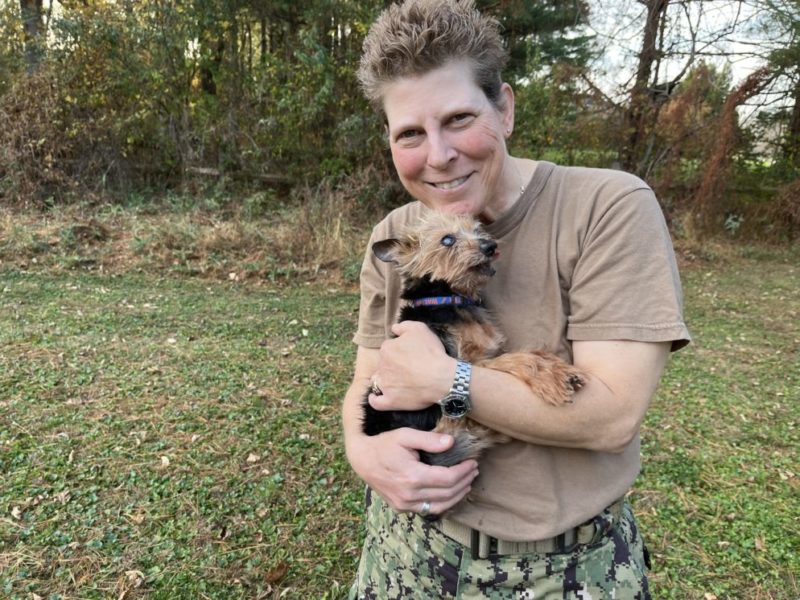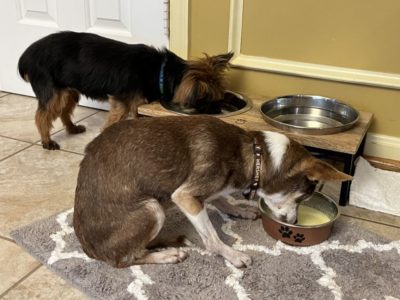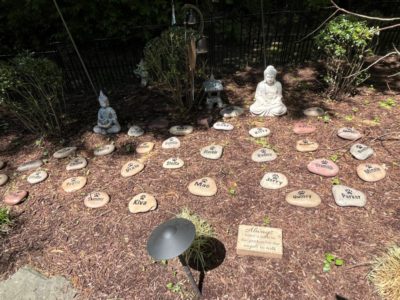
STORY AND PHOTOS By Andrea F. Siegel
Noses and eyes are trained toward this Rockville kitchen, where food is being prepared.
Impatient diners pace or whine, with one perched on the counter overseeing the process. The rest wait attentively for their meal.
This is dinnertime, and Risa Simon is feeding her brood: 16 small dogs and 12 cats on a fall day. On a recent spring Sunday, she was up to 17 dogs and 13 cats.
Her house is their retirement home, their haven, their hospice.
Simon, 51, a Navy captain with a Bronze Star for meritorious service in a combat zone, is an intelligence director in the Office of Naval Intelligence in Suitland. Her other mission is giving elderly, ailing pets TLC in the twilight of their lives.
Outside, the mailbox at Simon’s Colonial-style home says Leashes End, the nonprofit rescue-sanctuary for canines and felines that she runs here. She founded it seven years ago and moved to the spacious home on 2.7 acres to accommodate it.
A clue to what’s indoors are the “gate guards” that usually include dogs Trina and Mouse, wildly barking on the front steps.

Inside, the décor is overwhelmed by a sea of pet beds, with furry retirees napping, chewing, wandering — not spending their days caged. Dotting the scene are squishy animal toys, water bowls, cat condos, pee pads and so on. Spray disinfectant bottles and neatly stacked white towels grace end tables.
“There’s a roll of paper towels in every room,” says Simon.
“We are a rescue in the sense that we rescue them from bad situations and shelters,” Simon says, noting that many were abandoned, abused or neglected. Animals also come to her by word-of-mouth, rescue networks or are left anonymously on her doorstep.
“We are a sanctuary,” Simon says. No adoptions, but a couple of foster exceptions. “This is a haven to live out the rest of their lives. They are fed, they are cared for,” Simon says.
“They blossom here,” she says, getting substantial veterinary care, love, good nutrition and less stress. The cost of running Leashes End is $6-$9,000 a month. Donations and grants account for one-third; Simon covers the rest. Ailing animals require medical treatment that includes cardiac and dental care as well as removing tumors, as on Sadie, a 16-year-old puggle that has since died. She had a tumor that caused discomfort and was so big it kept her from squeezing through the doggie door. Gremlin, 13, a dog that arrived in late April, is “the poster child for medical expenses,” says Simon, because she faces thousands of dollars in treatment.
Leashes End has live-in staff supplemented by volunteers. Retired teacher Kathy Hougum of Potomac, who has volunteered at other pet rescues, has several roles here, including outreach and keeping an eye out for potential grants. “The animals are lucky to land here,” she says, noting the homey atmosphere.
“OK, let’s go for a walk,” Simon calls to the dogs in English, though she knows five other languages. Despite the rescue’s name, “We don’t do leashes,” says Simon. The yard is fenced.
“They go at their own pace. They walk where they want,” Simon says before darting back to scoop up Walter, an arthritic, nearly blind and almost deaf, 17-year-old Yorkie that had enough walk. No dog left behind.
For years, Simon envisioned creating a rescue in retirement for geriatric, small (under 25 pounds) dogs and cats, having taken care of an aunt’s fluffy Malteses once her aunt couldn’t.“Then, I realized there was a niche for senior dogs, dogs with special needs.”
Older then meant 10 or 11. “Now I have what I call super-seniors, 12 to 15,” she says. The current age range of Leashes End residents: 10 to 24.
Her plan morphed into starting the rescue in 2016, when her last overseas deployment to Iraq ended. She returned home to her husband and too many needy pets for their townhouse. The search began for a larger place, aided by money her aunt, who had died, left her.
Though she and her husband separated, he helps out. Two housemates – recently there were three — swap doing chores, such as feeding and endless cleaning up after incontinent animals, for living rent-free. They also work; their hours allow them some time to be with animals during weekdays, sometimes feeding meals, says Simon. Kari Mitchell one housemate, often cooks for the dogs. “The crockpot is always going,” Simon says.
“I love them all,” Marqua Crawley, another, says of the animals. “I do the morning chores after Risa [leaves].” For laundry, “everyone pitches in.”
The rescue requires about five loads daily, Simon says, plus most of her non-work hours. Up at 4 a.m., she cleans her pee-pad and towel-covered bedroom, does a load or two of laundry and turns on a radio tuned to classical music for the animals before heading to work by 6:30 a.m.
The house is chaotic upon Simon’s afternoon return, as yapping groupies try to crowd into the bathroom with her. Evenings are devoted to the animals and cuddling with them.
“Nobody sleeps alone,” says Simon. Generally, the dogs sleep with her – on her bed or on the floor, and the cats with her housemates.
The dogs generally get along, though an occasional dispute arises. Three dogs were rehomed or returned for problem behavior – group living isn’t for everyone – including biting.

Volunteers range from students earning service learning hours to retirees who miss having pets, and all enjoy petting the Leashes End residents.
Tamir Satterwhite, who will start 10th grade at Rockville High School this fall, says he is learning “how to better take care pets for the future, to be more responsible.”
His time at Leashes End has him appreciating the work that goes into taking care of pets, especially those in need, and he enjoys comforting the ones that seek human contact, like Lady Valentine, a cat. “I want to be there for them,” he says.
“I love the older ones because I got older, too,” says Rachel Maslan of Rockville, an administrator in a large company. “It’s nice that I am making a difference in their lives and helping them.” She also volunteers at the county animal shelter.
“It’s very calming to be around the animals,” says volunteer Jane DuMars, a part-time respiratory therapist who takes on whatever needs to be done and finds being with the animals calming, especially as they curl up on her lap. “In shelters, they live life in a cage,” she says.
“It’s knowing that their last weeks, months or years here are filled with love. It’s sort of like a human hospice, they get care,” she says.

“My main role was to feed the cats dinner once a week, but I clean up when I’m there. Some of them are incontinent. I do laundry, I give them attention,” said Michele Isaacson of Bethesda, a retired paralegal, who handles other duties also. “It’s not glorified at all, but I love all the animals; they are such sweet, old souls.”
Simon says she declined to consider a Navy position she had previously wanted because it would have required moving and her full attention. “My head wouldn’t be in it,” she says.
“Saying goodbye to pets,” Simon says, “is the hardest part.” Stones in her pet cemetery bear their names.
“They’ve taken over my house,” says Simon. “They’ve taken over my heart, for sure.”





Love it!